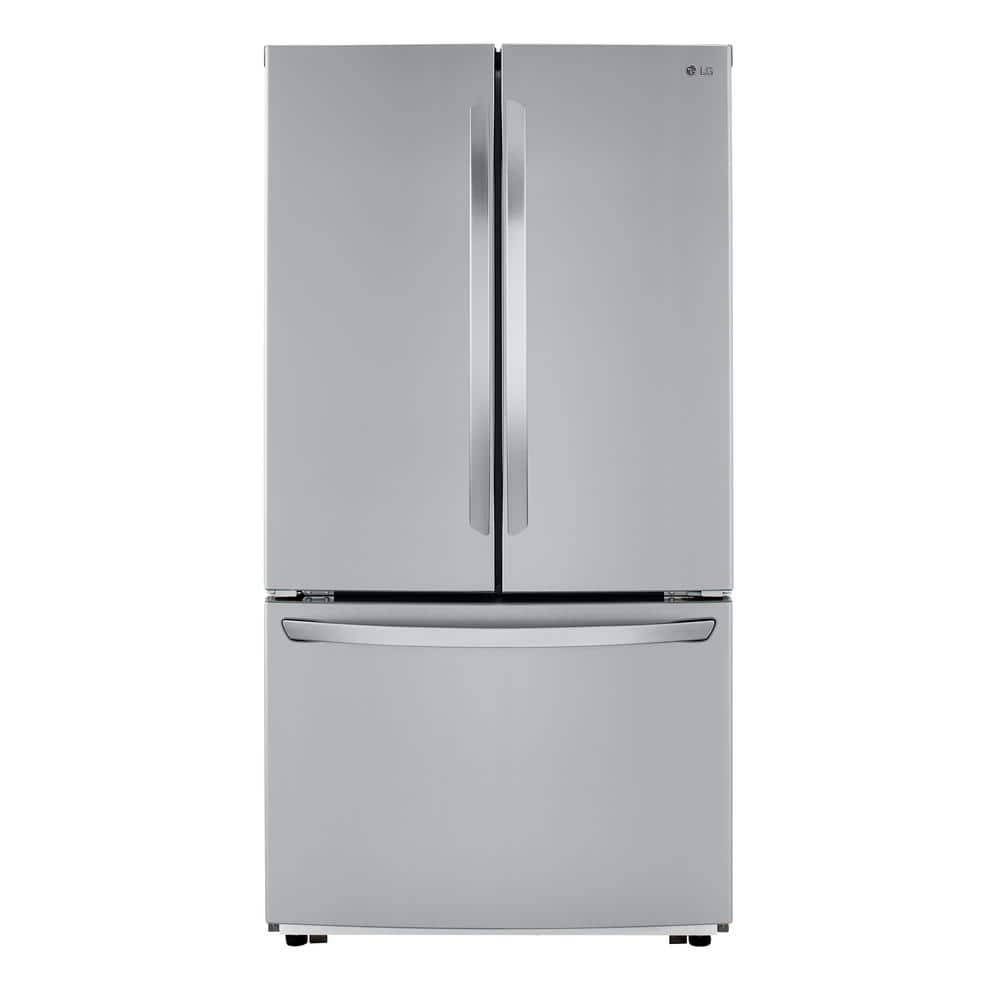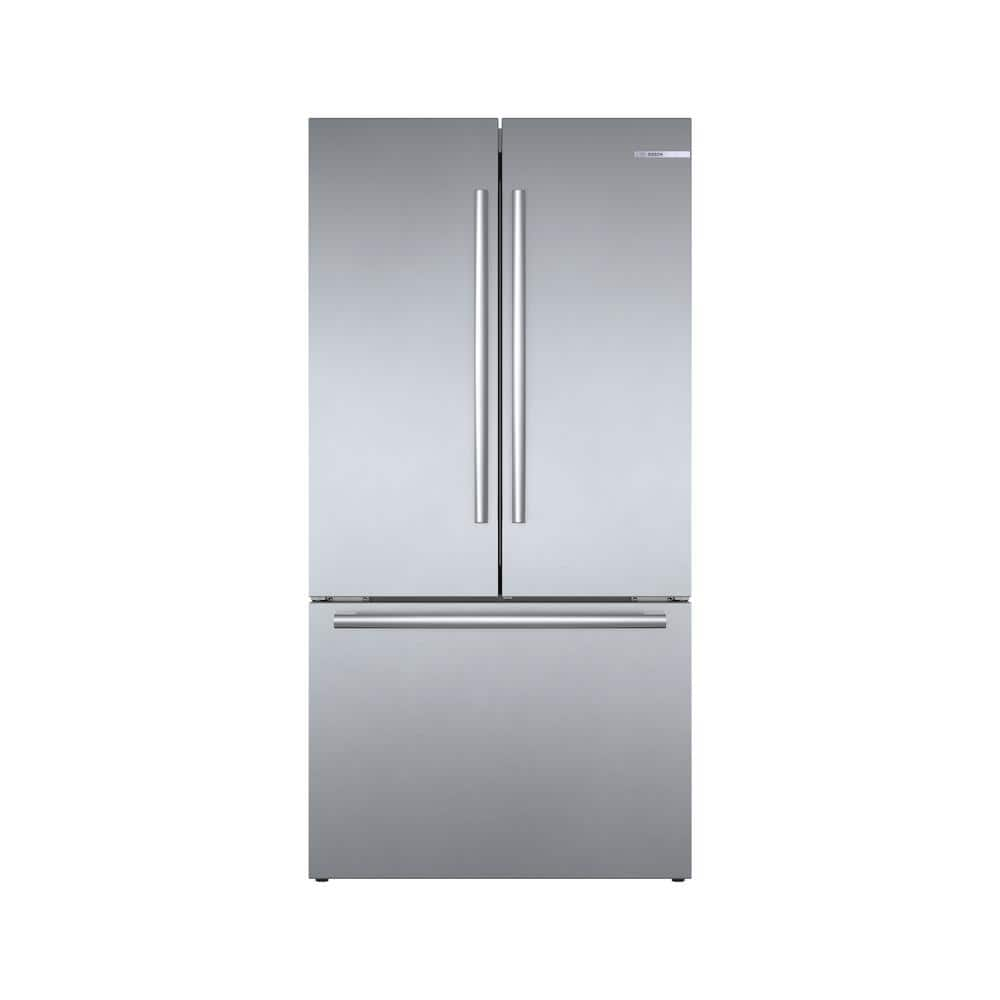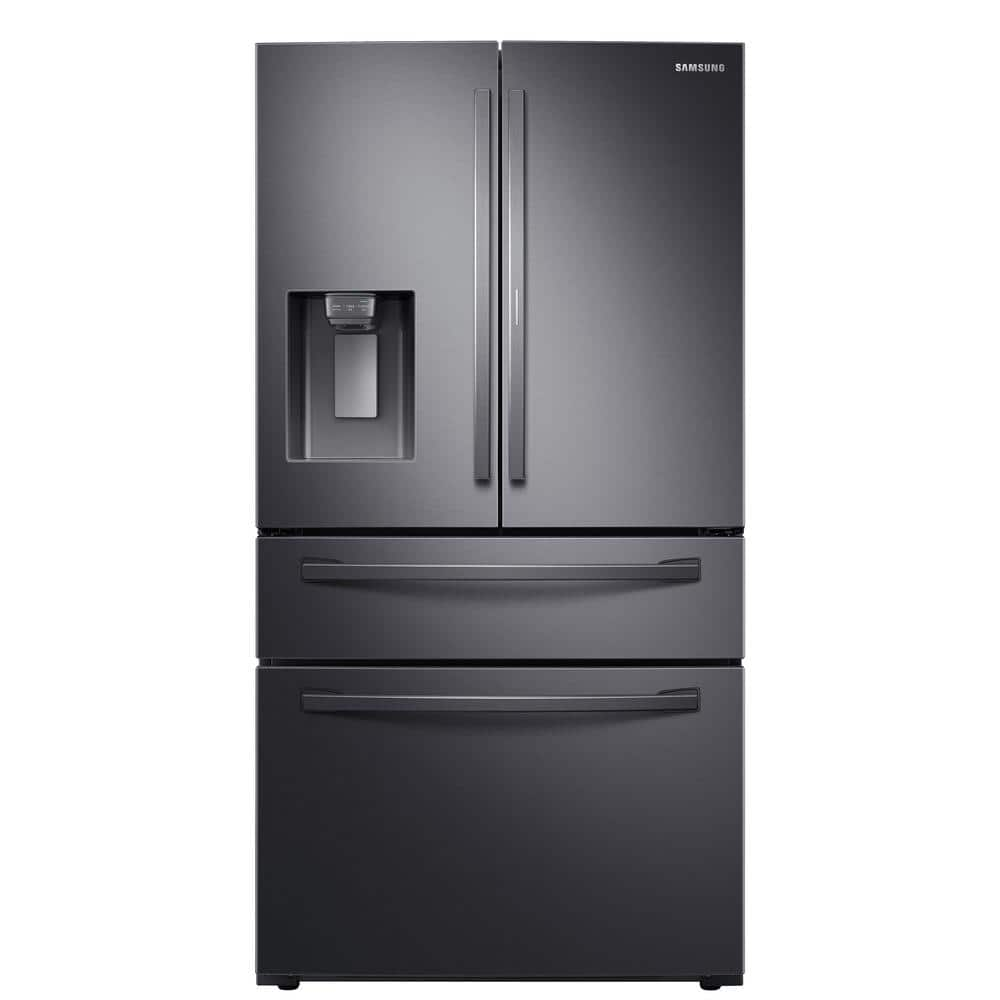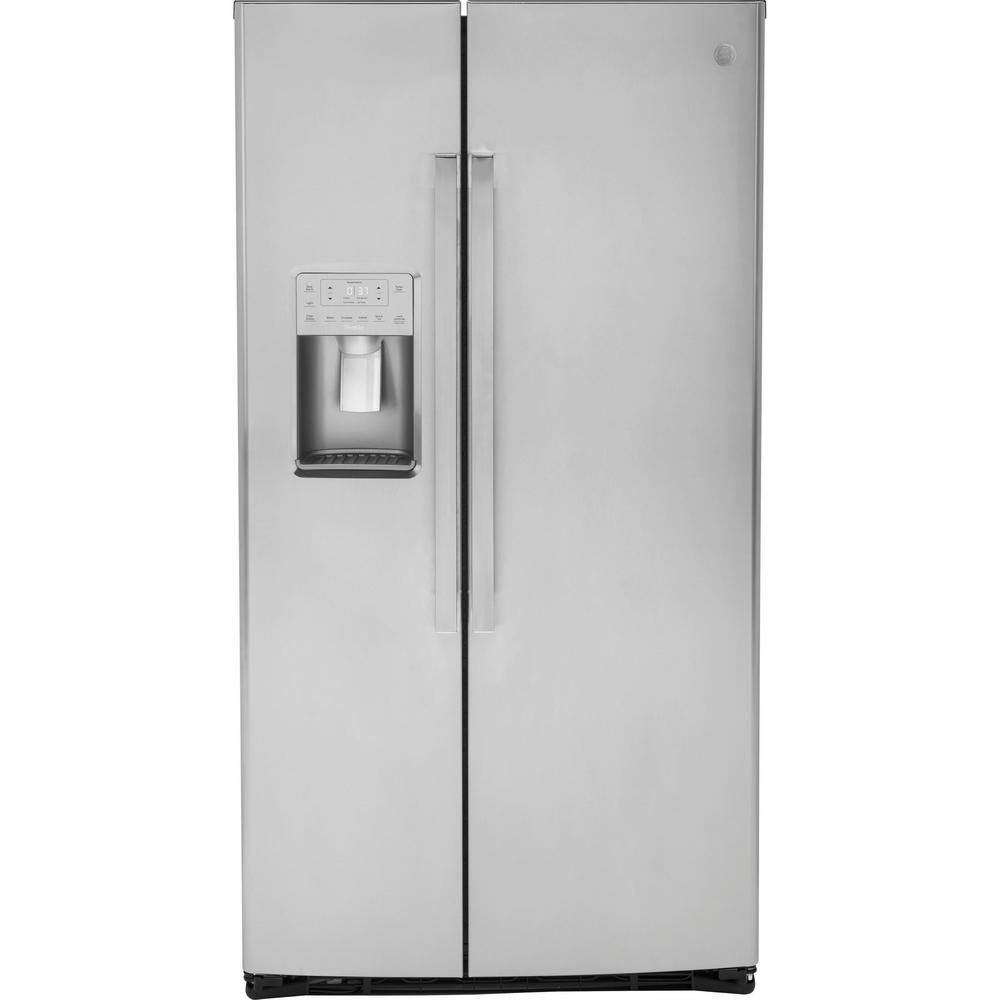Samsung 23 cu. ft. Smart Counter Depth 4-Door Flex™ refrigerator with Beverage Center and Dual Ice Maker in Black Stainless Steel Refrigerators – RF23A9671SG/AA | Samsung US
Smart Counter Depth 4-Door Flex™ refrigerator features the Beverage Center with both a water dispenser and AutoFill Water Pitcher, plus a Dual Ice Maker with Ice Bites, smaller nugget ice.
Press or pour – water two ways
Beverage Center provides quick access to refreshingly cool, filtered water two ways. Choose from an internal dispenser or a built-in pitcher that automatically refills, with the option to infuse with a flavor.
Ice your way
Enjoy your favorite beverage with your choice of ice. Select from cubed ice or Ice Bites that chill your drink faster.
Convert from fridge to freezer
Customize your lower-right storage space to be a refrigerator or freezer. With five adjustable settings, you choose what foods to store from fruits and vegetables to your favorite ice cream.
Superior organizational storage
With 23 cu. ft. of capacity, this spacious refrigerator is designed for convenience, offering unmatched flexibility and organization to store and access all your favorite foods with ease.
Seamlessly designed for a modern look
A modern, built-in look featuring a minimalist exterior with a signature flat door design and recessed handles that blend seamlessly into your kitchen.
Flexible freshness
A flexible storage drawer that is perfect for storing meats, veggies, or cheeses at their optimal temperature with two customizable temperature settings.
Fresh air, day after day
Keep the air in your fridge fresh day after day with a built-in deodorizing filter. The filter reduces odor from the air in your fridge, while UV technology continuously cleans the filter itself.
Powerful cooling performance
A premium cooling system featuring three evaporators for ultimate freshness and providing precise temperature and humidity controls in all three zones to help your food stay fresher longer.
Additional information
| Product Dimensions with Hinges, Handles and Door | 35 7/8" (L) x 71 7/8" (H) x 28 1/2" (D) |
|---|---|
| Product Dimensions without Hinges and Door | 35 7/8" (L) x 70 3/4" (H) x 24" (D) |
| Product Dimensions with Door without Handles | 35 7/8" (W) x 71 7/8" (H) x 28 1/2" (D) |
| Shipping Dimensions | 38 1/4" (L) x 77 5/8" (H) x 36 1/4" (D) |
| Net Depth with Door Handle | 28 1/2" |
| Net Height with Hinge | 71 7/8" |
| Net Height without Hinge | 70 3/4" |
| Net Depth w/o Door Handle | 28 1/2" |
| Width | 35 7/8" |
| Product Weight (lbs.) | 313.1 lbs |
| Shipping Weight (lbs.) | 335.1 lbs |
4 (four) is a number, numeral and digit. It is the natural number following 3 and preceding 5. It is a square number, the smallest semiprime and composite number, and is considered unlucky in many East Asian cultures.
Black is a color that results from the absence or complete absorption of visible light. It is an achromatic color, without chroma, like white and grey. It is often used symbolically or figuratively to represent darkness. Black and white have often been used to describe opposites such as good and evil, the Dark Ages versus the Age of Enlightenment, and night versus day. Since the Middle Ages, black has been the symbolic color of solemnity and authority, and for this reason it is still commonly worn by judges and magistrates.
Black was one of the first colors used by artists in Neolithic cave paintings. It was used in ancient Egypt and Greece as the color of the underworld. In the Roman Empire, it became the color of mourning, and over the centuries it was frequently associated with death, evil, witches, and magic. In the 14th century, it was worn by royalty, clergy, judges, and government officials in much of Europe. It became the color worn by English romantic poets, businessmen and statesmen in the 19th century, and a high fashion color in the 20th century. According to surveys in Europe and North America, it is the color most commonly associated with mourning, the end, secrets, magic, force, violence, fear, evil, and elegance.
Black is the most common ink color used for printing books, newspapers and documents, as it provides the highest contrast with white paper and thus is the easiest color to read. Similarly, black text on a white screen is the most common format used on computer screens. As of September 2019, the darkest material is made by MIT engineers from vertically aligned carbon nanotubes.
A door is a hinged or otherwise movable barrier that allows ingress (entry) into and egress (exit) from an enclosure. The created opening in the wall is a doorway or portal. A door's essential and primary purpose is to provide security by controlling access to the doorway (portal). Conventionally, it is a panel that fits into the doorway of a building, room, or vehicle. Doors are generally made of a material suited to the door's task. They are commonly attached by hinges, but can move by other means, such as slides or counterbalancing.
The door may be able to move in various ways (at angles away from the doorway/portal, by sliding on a plane parallel to the frame, by folding in angles on a parallel plane, or by spinning along an axis at the center of the frame) to allow or prevent ingress or egress. In most cases, a door's interior matches its exterior side. But in other cases (e.g., a vehicle door) the two sides are radically different.
Many doors incorporate locking mechanisms to ensure that only some people can open them (such as with a key). Doors may have devices such as knockers or doorbells by which people outside announce their presence. Apart from providing access into and out of a space, doors may have the secondary functions of ensuring privacy by preventing unwanted attention from outsiders, of separating areas with different functions, of allowing light to pass into and out of a space, of controlling ventilation or air drafts so that interiors may be more effectively heated or cooled, of dampening noise, and of blocking the spread of fire.
Doors can have aesthetic, symbolic, ritualistic purposes. Receiving the key to a door can signify a change in status from outsider to insider. Doors and doorways frequently appear in literature and the arts with metaphorical or allegorical import as a portent of change.
Ice is water that is frozen into a solid state, typically forming at or below temperatures of 0 °C, 32 °F, or 273.15 K. It occurs naturally on Earth, on other planets, in Oort cloud objects, and as interstellar ice. As a naturally occurring crystalline inorganic solid with an ordered structure, ice is considered to be a mineral. Depending on the presence of impurities such as particles of soil or bubbles of air, it can appear transparent or a more or less opaque bluish-white color.
Virtually all of the ice on Earth is of a hexagonal crystalline structure denoted as ice Ih (spoken as "ice one h"). Depending on temperature and pressure, at least nineteen phases (packing geometries) can exist. The most common phase transition to ice Ih occurs when liquid water is cooled below 0 °C (273.15 K, 32 °F) at standard atmospheric pressure. When water is cooled rapidly (quenching), up to three types of amorphous ice can form. Interstellar ice is overwhelmingly low-density amorphous ice (LDA), which likely makes LDA ice the most abundant type in the universe. When cooled slowly, correlated proton tunneling occurs below −253.15 °C (20 K, −423.67 °F) giving rise to macroscopic quantum phenomena.
Ice is abundant on the Earth's surface, particularly in the polar regions and above the snow line, where it can aggregate from snow to form glaciers and ice sheets. As snowflakes and hail, ice is a common form of precipitation, and it may also be deposited directly by water vapor as frost. The transition from ice to water is melting and from ice directly to water vapor is sublimation. These processes plays a key role in Earth's water cycle and climate. In the recent decades, ice volume on Earth has been decreasing due to climate change. The largest declines have occurred in the Arctic and in the mountains located outside of the polar regions. The loss of grounded ice (as opposed to floating sea ice) is the primary contributor to sea level rise.
Humans have been using ice for various purposes for thousands of years. Some historic structures designed to hold ice to provide cooling are over 2,000 years old. Before the invention of refrigeration technology, the only way to safely store food without modifying it through preservatives was to use ice. Sufficiently solid surface ice makes waterways accessible to land transport during winter, and dedicated ice roads may be maintained. Ice also plays a major role in winter sports.
A refrigerator, commonly shortened to fridge, is a commercial and home appliance consisting of a thermally insulated compartment and a heat pump (mechanical, electronic or chemical) that transfers heat from its inside to its external environment so that its inside is cooled to a temperature below the room temperature. Refrigeration is an essential food storage technique around the world. The low temperature reduces the reproduction rate of bacteria, so the refrigerator lowers the rate of spoilage. A refrigerator maintains a temperature a few degrees above the freezing point of water. The optimal temperature range for perishable food storage is 3 to 5 °C (37 to 41 °F). A freezer is a specialized refrigerator, or portion of a refrigerator, that maintains its contents’ temperature below the freezing point of water. The refrigerator replaced the icebox, which had been a common household appliance for almost a century and a half. The United States Food and Drug Administration recommends that the refrigerator be kept at or below 4 °C (40 °F) and that the freezer be regulated at −18 °C (0 °F).
The first cooling systems for food involved ice. Artificial refrigeration began in the mid-1750s, and developed in the early 1800s. In 1834, the first working vapor-compression refrigeration system, using the same technology seen in air conditioners, was built. The first commercial ice-making machine was invented in 1854. In 1913, refrigerators for home use were invented. In 1923 Frigidaire introduced the first self-contained unit. The introduction of Freon in the 1920s expanded the refrigerator market during the 1930s. Home freezers as separate compartments (larger than necessary just for ice cubes) were introduced in 1940. Frozen foods, previously a luxury item, became commonplace.
Freezer units are used in households as well as in industry and commerce. Commercial refrigerator and freezer units were in use for almost 40 years prior to the common home models. The freezer-over-refrigerator style had been the basic style since the 1940s, until modern, side-by-side refrigerators broke the trend. A vapor compression cycle is used in most household refrigerators, refrigerator–freezers and freezers. Newer refrigerators may include automatic defrosting, chilled water, and ice from a dispenser in the door.
Domestic refrigerators and freezers for food storage are made in a range of sizes. Among the smallest are Peltier-type refrigerators designed to chill beverages. A large domestic refrigerator stands as tall as a person and may be about one metre (3 ft 3 in) wide with a capacity of 0.6 m3 (21 cu ft). Refrigerators and freezers may be free standing, or built into a kitchen. The refrigerator allows the modern household to keep food fresh for longer than before. Freezers allow people to buy perishable food in bulk and eat it at leisure, and make bulk purchases.
Samsung Group (Korean: 삼성; pronounced [samsʌŋ]; stylised as SΛMSUNG) is a South Korean multinational manufacturing conglomerate headquartered in the Samsung Town office complex in Seoul. The group consists of numerous affiliated businesses, most of which operate under the Samsung brand, and is the largest chaebol (business conglomerate) in South Korea. As of 2024, Samsung has the world's fifth-highest brand value.
Founded in 1938 by Lee Byung-chul as a trading company, Samsung diversified into various sectors, including food processing, textiles, insurance, securities, and retail, over the next three decades. In the late 1960s, Samsung entered the electronics industry, followed by the construction and shipbuilding sectors in the mid-1970s—areas that would fuel its future growth. After Lee died in 1987, Samsung was divided into five business groups: Samsung Group, Shinsegae Group, CJ Group, Hansol Group, and JoongAng Group.
Key affiliates of Samsung include Samsung Electronics, the world's largest information technology company, consumer electronics maker and chipmaker by 2017 revenues; Samsung Heavy Industries, the world's second-largest shipbuilder by 2010 revenues; and Samsung Engineering and Samsung C&T Corporation, ranked 13th and 36th among global construction companies, respectively. Other significant subsidiaries are Samsung Life Insurance, the 14th-largest life insurance company globally, Samsung Everland, operator of Everland Resort (South Korea's oldest theme park), and Cheil Worldwide, the world's 15th-largest advertising agency by 2012 revenues.







by Andrew
I can’t believe how much food we have been able to get into this refrigerator. It’s downright cavernous. It also looks great in the kitchen, and is the focal point of the room. It has a host of cool features, including the dual ice maker (our favorite thing), flex compartment that can be fridge or freezer as desired, auto-fill water pitcher in the beverage center, oversize bins in all of the doors, UV deodorizing function, door alarm, and on top of all this, it works with the SmartThings app! It runs fairly quietly, with the loudest part being when it dumps fresh ice into the bins. Even that isn’t all that loud (our cats would disagree). The stainless finish does show fingerprints, but a dry microfiber cloth wipes them right off. We couldn’t be happier with this fridge, unless the ice maker dumped out money instead of ice cubes. We have the Samsung washer and dryer set, which we love as well, and this fridge has only raised our opinion of Samsung appliances.
by Kimi
This is a gorgeous appliance! Sleek, modern, and ultra cool. There is so much space in this fridge, that it took me a bit to fill it up! It also easily hooks up to my existing Samsung SmartThings app, so I can control the fridge via WiFi, just like my Samsung laundry pair.
The flex compartment on the lower right is a big bonus, especially if you happen to need some extra fridge space, or want to set part of the freezer at a warmer temp for keeping ice cream soft. The main con about the freezer is that you can’t store anything big in it, like a long package of chicken or extra large pizzas. The other con is that it begins to frost up quickly, if you have the door open for more than a few seconds.
The beverage center is accessed through the partial door on the top left, without having to open the rest of the fridge. I use the auto-fill pitcher often. The water in the pitcher is colder than the water that comes from the regular dispenser. I haven’t tried the infuser in the pitcher.
My fave part of this fridge is the dual ice maker! One bin gets large cubes and the other gets bite-sized cubes. The unit makes a lot of ice.
All in all, this is a great fridge, and we love it! I hope it lasts a long time. I’ve already been telling everyone about it, and showing off all the neat features that it has. At least one person has said they want one. This fridge makes my third Samsung appliance (laundry pair is the other two), so now I need the range, microwave, and dishwasher to complete my set!
by Manny
it’s only been two weeks, so this review in no way attests to the product’s reliability. we really like the refrigerator as it is very modern and clean looking. the twin ice maker is great and keeps churning out more ice than i can use, which wasn’t the case with my prior door amounted ice dispenser. the freezer compartment is nicely divided into two sections with multiple drawers and shelves, which means you don’t have to pile food on top of each other, like in a pull-out drawer. i also like the beverage section, which allows you to access it using the outside door, rather than the full door. i definitely recommend it, now let’s hope it lasts a long time, unlike my last lg fridge, which completely failed at 3 years.
by Malron
There are so many things to love about the Samsung 23 cu. ft. Smart Counter Depth 4-Door Flex™ Refrigerator with Beverage Center & Dual Ice Maker RF23A9671SR/AA – Stainless Steel.
The beverage center with fruit infused water container is my all time favorite. The different size Ice cubes is my second favorite feature. The roominess of the top refrigerator Portion is well lit, and has enough space for everything.
by James
This fridge has everything that you need in a fridge and more. The built in filtered water pitcher gives you fresh cold water throughout the day. My favorite feature in the ice machine that has cubed an mini ice. My wife likes how you can set different settings in the drawers for best results with certain fruits and vegetables. Cleaning this fridge is a breeze inside and out.